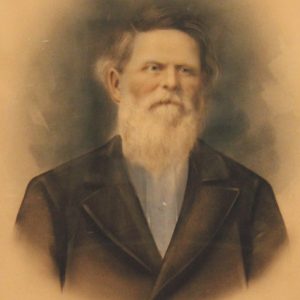calsfoundation@cals.org
Simon Sager (1802–1864)
Simon Sager and his family are believed to have been the first white settlers in Hico (now Siloam Springs in Benton County)—part of a massive influx of skilled German immigrants into the United States and northwestern Arkansas that began in the 1830s.
Simon Sager was born in 1802 in Wurttemberg, Germany. He married Wilhemina Charlotte Meyers of Baden, Germany, around 1825. The couple had eleven children. Sager followed his father in working as a cabinetmaker and builder.
In 1836, Sager, his wife and five children, two brothers, and a cousin left Prussia, a large state in northern Germany, because of economic hardship and the political climate of the country. They arrived in Baltimore, Maryland, on January 1, 1837, and, from there, went to Philadelphia, Pennsylvania, then to St. Louis, Missouri, and on to Westport, Missouri. One of Sager’s brothers stayed in Westport, but the rest of the group traveled to Arkansas in 1839.
Sager became a plantation owner in Hico, where he farmed and raised cattle. He accumulated his property through land patents and earned a living as a builder, cattleman, and cattle drover. Sager, his brothers, and his cousin were noted woodworkers and had been trained in Prussia by Sager’s father. Sager built more than one family cabin. Today, the 1844–1845 Simon Sager cabin is the oldest permanent structure in Siloam Springs and is listed on the National Register of Historic Places. The cabin sits on the campus of John Brown University.
Sager was hired by the Cherokee Indians to help build their Male Academy and Female Academy in Tahlequah, Oklahoma, from 1848 to 1851. He also owned cattle and—as a forerunner to the Southwest cattle drives to Kansas City, Missouri, after the Civil War—began driving his herds to market over part of the Trail of Tears.
Some of Sager’s handcrafted furniture still exists, along with furniture made by his brother Christian Christopher Sager and cousin Frederick Greene at their water-powered mill in Prairie Creek (Benton County). Several of their pieces are on display in the Siloam Springs Museum, the Rogers Historical Museum, the Shiloh Museum of Ozark History, and the Arkansas Museum of Natural Resources. A jelly cupboard made of pine and a pie safe made of walnut in the Arkansas Museum of Natural Resources are attributed to Sager. A secretary desk with a cherry base and a walnut top and a walnut and oak secretary in the same museum are attributed to Sager or to Christian Sager and Frederick Greene.
The first Methodist church in the area began in Sager’s home. Sager was known as a good manager of his affairs, a gentle and pious man, and a friend to the Native Americans and area settlers.
On May 17, 1864, a group of Cherokee “Pin” Indians (who were pro-Union guerrillas) on a raid in the area surrounded Sager at this cabin and killed him. Sager was buried in the Hico Cemetery. Sager Creek, near the Sager cabin, and the Sager Creek Arts Center in Siloam Springs are named for him.
For additional information:
Park, Shirley Harris. “Sager-Greene Ledger, 1840–1867.” Permanent display. Rogers Historical Museum, Rogers, Arkansas.
Rogers Historical Museum. The Sagers: Pioneer Cabinetmakers. Rogers, AR: Rogers Historical Museum, 1996.
Smith, Maggie. Simon Sager Celebration. Siloam Springs, AR: The Simon Sager Press, 1966.
Marilyn Harris Collins
Rogers, Arkansas


 Simon Sager
Simon Sager 




I’m working on a database of Lippe-Detmold immigrants (www.lippe-auswanderer.de). Today I searched for Simon Sager and found this interesting article. But there is a mistake in his and his wife birthplaces. These are the exact dates:
Saeger (Sager) Simon Heinrich Hermann
* 14.05.1804 in Sabbenhausen.
17.05.1864 in Siloam Springs, Benton (Arkansas)
oo 01.10.1827 with
Meier oder Eggerding Wilhelmine Charlotte, * 15.11.1805 in Woerderfeld
Both places are in North Rhine-Westphalia, Germany.
[Editor’s note: We were unable to confirm this information.]